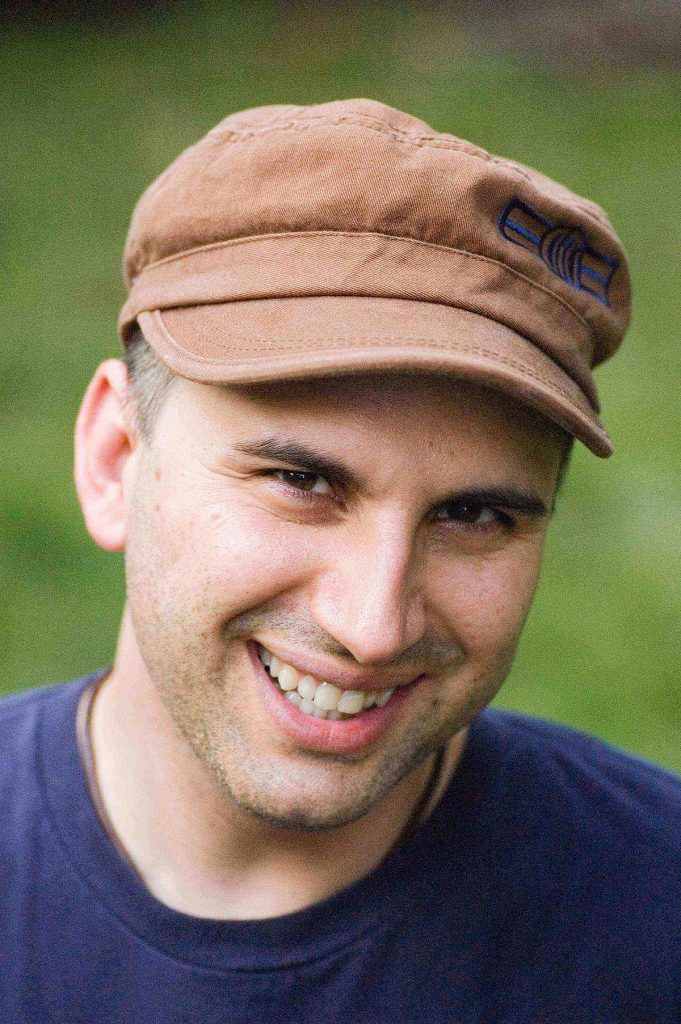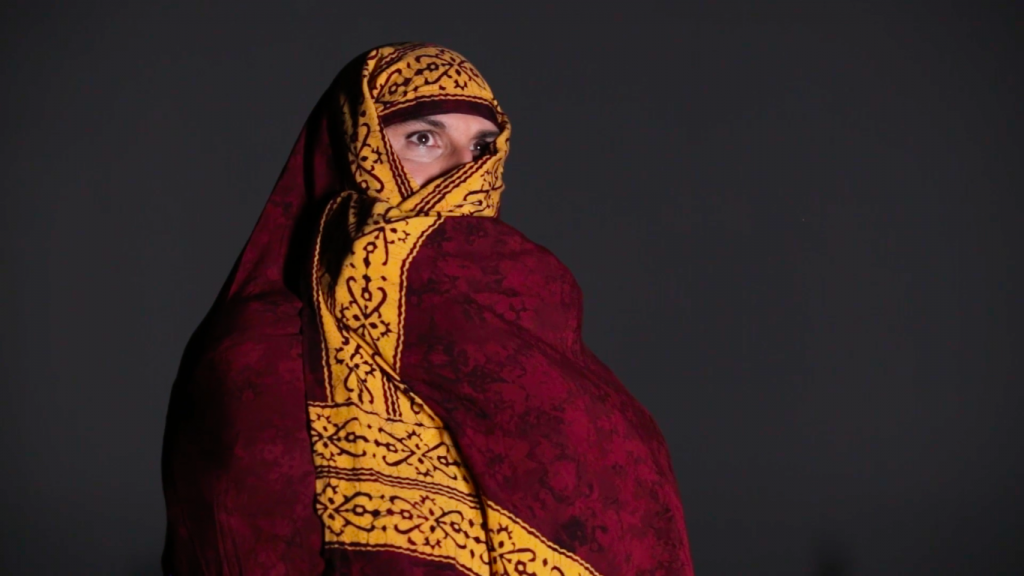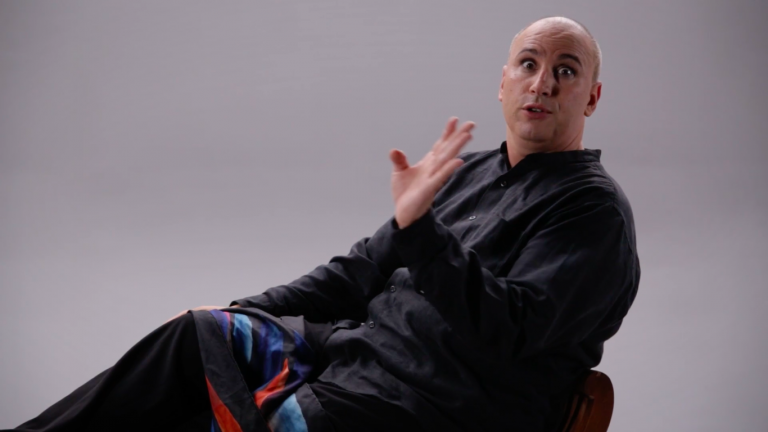Peterson Toscano is both very funny and very serious. After spending 17 years in gay conversion therapy, he’s come out as a comic and queer rights activist.
Peterson will be visiting Iceland for a performance hosted by Wotever Iceland at bar Gaukurinn in Reykjuavík on June 1st. There he will be performing scenes from his latest movie, called Transfigurations, which looks at different gender non-conforming characters in the Bible. My first question for him is: “What can people expect from your performance?

“One, I will talk about my experience receiving conversion therapy. I’ll actually do comedy about that, scenes from my play Doin’ Time in the Homo No Mo Halfway House. It is disturbing and hilarious at the same time. And I’ll then share the work that I’ve done in exposing the many gender non-conforming Bible characters.”
What sparked your interest in looking at gender non-conforming characters in the Bible?
“Many of us who are LGBTQ, we were bullied first because of our gender. We weren’t acting like ‘real boys’ or ‘real girls.’ And most of the violence toward queer people is toward trans people, particularly trans women of colour. It’s because people are breaking the rules around gender, according to the rules that people set up. So when I came out gay after all those years in conversion therapy, I had to realize that half of what I was running from was gender policing. I wanted to get at this both for the anti-gay folks and the pro-gay folks, because I think we all have gender trouble to sort out.”
What’s it like for you to revisit your time in gay conversion therapy each time you step onto the stage?
“It can be very traumatic. For any of us who have experienced trauma, no matter what it is, telling our stories again can re-traumatize us. And I’ve had interviews where people have really pressed in and wanted me to access emotions from back
“I will talk about my experience receiving conversion therapy. … I’ll then share the work that I’ve done in exposing the many gender non-conforming Bible characters.”
then that’s really been triggering for me. I don’t actually perform the whole play Doin’ Time in the Homo No Mo Halfway House anymore, I just do this one opening scene, because to do more so at this point would be just too much.”
After you left conversion therapy, why did you continue to be so interested in religion?
“In part because there needs to be justice work done around this. But also because these stories, at least for people in the United States, the Bible is not just some ancient document that’s referenced in religious ceremonies. Literally foreign policy is based on certain readings of the Book of Revelation. They’re basing certain laws on how they reads these books, they’re treating children like outcasts based on how they interpret it. So it’s a very modern problem, so there needs to be some people who are literate and able to communicate ideas and truth to these texts.”
What kind of research was involved in the Transfigurations project?

“As a cisgender gay man I didn’t know a lot about the transgender experience. As part of my coming out experience I began to read books, watch films and interview people who are transgender, genderqueer or gender non-conforming. And I just soaked in these stories. And then I went to the Bible, and I know the Bible very well, and I know that the Bible has very strict rules when it comes to gender. So it’s not terribly difficult to see if someone is misbehaving. So I just went and said, ‘Who’s misbehaving in the Bible?’ And I was shocked to find so many people, more than I could fit in the play, of people who were breaking the rules around gender. And they were almost always positive stories about people who were essential to the plot. Without them the whole thing would fall apart.”
You also mentioned you might bring up another one of your interests — queer responses to climate change — at your Wotever Iceland performance. What do you mean by a ‘queer response to climate change’?
“I think most LGBTQ people will say that climate change is happening, but I don’t think a lot of us are part of any real solution. If you think about impacts, this is the issue that impacts the most people on the planet and can potentially be devastating to us as earthlings. And for the most part it’s been looked after by straight, white, middle-class environmentalists who look at it in very narrow terms and appeal to straight, white, middle-class people. They say, ‘Think about the children and the
“Many of us who are LGBTQ, we were bullied because … we weren’t acting like ‘real boys’ or ‘real girls.’ … So when I came out gay after … conversion therapy, I had to realize that half of what I was running from was gender policing.”
grandchildren.’ And although there are queer people who have offspring, most of us don’t. They also see it as something to do with the environment, and when people think of the environment they think of pristine, wildlife places. But LGBTQ people have a complicated relationship with nature. Many of us found more refuge in cities because we had to flee rural spaces, and in fact we were told our desires were unnatural, we were somehow sinning against nature. So I feel like the whole discussion needs to be reframed. It needs queer eyes on it.”
How are you able to weave all these different topics together, from your time in gay conversion therapy to climate change?
“I do a show called Everything is Connected, and I’m going to probably lean on that. In that show I tell my own story about trying to de-gay myself. Then I tell the story of Joseph in Genesis with the princess dress. And then I talk about how that’s also a climate story. In that Joseph lived in Egypt and predicted climate change. In the

story he predicted that there would be a drought. So he predicts climate change and then he comes up with an adaptation plan. But his plan was not perfect, it wasn’t just and led to oppression and slavery. So a queer response to climate change would be recognizing that it doesn’t affect everyone the same and coming up with a solution that doesn’t worsen the conditions that already exist in the world.”
What do you hope people will take away from your show at Gaukurinn?
“What I really hope is that is stimulates thinking. I really love critical thinking and I want people to walk away with their brains buzzing and their hearts warmed. I don’t want people to walk away with one idea, I want people to walk away with their idea and then run with it.”
Peterson Toscano will be performing scenes from his latest film at Gaukurinn on June 1, at an event hosted by Wotever Iceland. Doors open at 19:00 and cover is 1,000 ISK.


